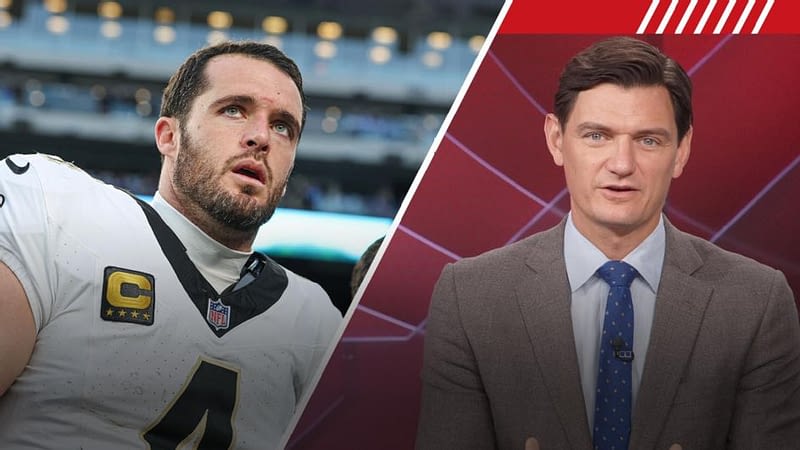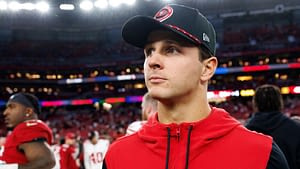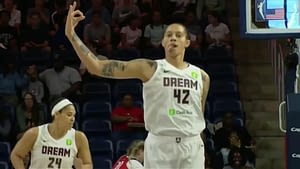Kellen Moore Faces the Music: Derek Carr’s Unexpected Retirement Leaves Saints in Limbo
In the heart of Metairie, Louisiana, the New Orleans Saints’ new head coach, Kellen Moore, found himself in a whirlwind of questions and uncertainty. Just three months into his tenure, Moore was thrust into the spotlight, facing a barrage of inquiries about a player he had never coached or even met in person. The sudden retirement of quarterback Derek Carr had left the Saints and their fans in shock.
The announcement came just three hours before Moore’s press conference, with the team revealing that Carr had experienced pain in his throwing shoulder during his first significant throwing session of the offseason. Scans showed a torn right labrum and “significant degenerative changes to his rotator cuff.” The dual statement from Carr and the team on May 10 left many questions unanswered, and Moore was left to navigate the storm.
During the press conference, Moore was bombarded with 23 questions, ranging from the timing of Carr’s decision to retire to the nature of his injury. Despite the intense scrutiny, Moore remained tight-lipped, offering praise for Carr and discussing “the process” without providing any substantial details. Carr himself has not spoken publicly about his retirement, leaving many within the Saints organization and the league puzzled and searching for answers.
While everyone agrees that Carr is injured, not everyone believes that the injury is the sole reason for his retirement. Rumors had been circulating within league circles that Carr, who was entering the third season of a four-year, $150 million contract with the Saints, was open to playing for a new team. A representative for Carr had even reached out to at least two teams in need of a quarterback, according to three league sources.
However, a Saints source stated that no written permission was given for Carr to speak to other teams. Another source mentioned that while the team was aware of Carr’s potential interest in other teams, they didn’t see it as a major issue. Carr, after 11 years in the league and playing through injuries, had earned the right to evaluate his future. Despite the whispers, talks with other teams never reached a serious point.
So, why would Carr consider leaving New Orleans? Those close to him have their theories. One team source suggested that Carr had a strong connection with the previous season’s offensive coaches, Klint Kubiak and Andrew Janocko, and had hoped they would return. The departure of head coach Dennis Allen, who had drafted Carr as a Raider and brought him to New Orleans, also played a role. Additionally, the Saints’ plan to restructure Carr’s contract may have caused friction, though Moore declined to comment on whether the team had asked Carr to take a pay cut.
Despite these challenges, Moore had been unable to improve the relationship. In his introductory press conference on February 13, Moore was noncommittal about Carr as the starter, though he praised the quarterback he had faced during his own playing days at Boise State.
When asked to clarify Carr’s status as the starting quarterback, Moore’s responses were vague. “Derek’s a tremendous quarterback in this league,” Moore said. “I’ve had so much respect for him. The journey that he’s been on, he’s a starter in this league. He’s a premier player in this league. He’s had a great journey obviously going from Fresno State to the Raiders and now here. Really excited to team up with him and go through this process.”
An AFC executive believed that Moore had every intention of working with Carr, at least for the 2025 season. “A lot of the guys that interviewed [for the Saints head coaching job] thought they would have Derek,” the exec said. “That was part of the appeal — the [Saints] offense and what it was when healthy.”
However, Moore understood that the Saints were likely headed toward quarterback purgatory. The 2025 season was the last with guaranteed money on Carr’s contract, and after two years without a playoff berth, the Saints and Carr seemed poised for a breakup in 2026 unless undeniable chemistry developed between the quarterback and coach.
- Moore received “mixed signals” about Carr’s plans this offseason, according to multiple sources.
- When Carr didn’t show up for voluntary workouts, it was noted as rare for an established QB1 to be absent.
- Without offering specifics, Carr mentioned during a guest sermon in April that he and his wife had planned to fly to New Orleans earlier in the offseason but were delayed due to personal health issues.
Multiple team sources did not recall seeing Carr in the building this offseason, and one source believed Carr’s communication with teammates was minimal. While offensive coaches were in touch with Carr, the conversations were more about life than football.
Given this context, both parties might have understood that a separation was possible. However, there was no discussion of a potential career-ending injury in talks of an impending split or in Carr’s conversations with other teams.
To be sure, Carr’s injuries were a significant theme of the Saints’ disappointing 2024 season. After a 9-8 record in 2023, Carr was limited to 10 games in 2024. He left a game against the Chiefs on October 7 due to an oblique injury, and second-year player Jake Haener replaced him. The Saints then started Spencer Rattler the following week.
Carr returned a month later to a team with a 2-6 record, winning three of his next five starts to keep New Orleans in the playoff race. However, he injured his non-throwing hand and suffered a concussion in a win over the Giants on December 8, ending his season. The Saints, who had fired Allen and replaced him with special teams coach Darren Rizzi, did not win again.
Eleven days after the win against the Giants, Rizzi addressed a report that Carr was “very unlikely” to return due to the hand injury. “He wants to come back and play this season,” Rizzi said on December 19. “There’s absolutely zero doubt about that. He’s in here every day doing everything that he possibly can from a rehab standpoint to get himself back on the field.”
Several team sources said the main issue around Carr’s late-season availability was the left hand injury. Carr worked to return, but one player source recalled that Carr was able to throw but “couldn’t take a snap.” A shoulder injury never appeared on the injury report during the 2024 season, and a team source said Carr went through a routine physical at the end of the season without any shoulder issues being raised.
This is why questions and curiosity linger among some in the Saints building about the injury that led to Carr’s retirement. “What we thought was his injury going into [2025] looks a lot different now,” said a team source. Those same sources acknowledged that Carr has played through injuries throughout his 11-year career and could have accumulated shoulder issues over time.
“He wasn’t in the mode of doing heavy throwing late in the year, and he tried to get ready, but the wrist just wasn’t there yet, so it’s possible he didn’t discover problems [in the shoulder] until he started to do more,” a Saints coaching source said about Carr’s late-season process.
The exact timing of the labrum injury is unclear, as is when Carr reported shoulder pain to the Saints. While multiple team sources said they learned about Carr’s injury around late March, a Saints coaching source said he first heard about it when an April 11 report surfaced on NFL Network.
Whenever the notification occurred, the team “got [the shoulder] looked at, found out what was going on” and hoped for the best, according to a high-ranking Saints source. “When he said pain, we’re not thinking retirement,” the source said. Carr attempted to rehab the injury but realized that functioning with it would be an arduous task, as outlined in the team’s statement. Both sides wanted to see how the injury would respond to rehab.
Still, the belief among two player sources and one league source is that Carr had been considering retirement well before the shoulder problem was apparent, even if he was simply taking stock of his career as the season concluded.
Then why gauge interest from other teams? One source with knowledge of the situation said Carr was considering his options. Even if retirement was a consideration, it wasn’t a solidified plan. Carr wouldn’t have been clear on the extent of the shoulder issue in early March when evaluating his potential market.
Would a Carr retirement announcement in February have prompted New Orleans to pursue a veteran on a high-priced contract like Sam Darnold? One team source said such a move would have been tough due to the $40 million in guarantees for Carr in 2025. “I think the draft was always the most logical play,” the source said.
The Saints did extensive work on quarterbacks in the 2025 draft, and several league sources believe New Orleans spent significant time evaluating two in particular: Ole Miss’ Jaxson Dart and Louisville’s Tyler Shough, whom they eventually selected at No. 40.
Multiple rival teams wondered if the Saints would move up in the draft to select a quarterback. The New York Giants did so, trading up to select Dart at No. 25. The Saints chose to remain patient, getting Shough at No. 40. Now the 25-year-old rookie might be their best option.
One day after the season ended, Carr met the media. He addressed his contract, telling ESPN he would not take a pay cut but would be happy to restructure to help the team. He discussed his hand injury, saying he wouldn’t need surgery, but did not mention a shoulder problem.
“I’m probably still a little bit away from getting cleared from all of that stuff,” Carr said. “I did everything I could to try and be out there. I’m appreciative to the organization and Coach Rizz for giving me that chance. … It came down to, I just couldn’t hold a football. That’s kind of important to do.”
Whatever his thoughts about retirement, Carr struck a positive tone about a future in New Orleans. “I feel excited about being here because I feel like we finally, not only, the last 16, 17 games, played really well, but also my wife and I have been able to do what we do in the community. … I’m super passionate about this city, our fans, this organization.”
Carr was already well on his way to $200 million in career earnings. He had played through various systems and coaching staffs. Moore would have represented his seventh head coach and eighth playcaller since entering the league in 2014. He has played through many injuries — including a serious one with the labrum that hadn’t even been known. Within that context, his retirement should have perhaps been unsurprising.
As for a move to another team, Carr’s $30 million in guaranteed salary and $10 million roster bonus “certainly didn’t help” his attractiveness for a trade, according to a source from a team in the market for a quarterback. Money would have complicated any trade talks, had they intensified.
The Cleveland Browns decided to run it back with Joe Flacco while trading for Kenny Pickett and drafting Dillon Gabriel and Shedeur Sanders. The Titans, whose head coach Brian Callahan oversaw Carr’s quarterback room with the Raiders in 2018, selected Cam Ward with the No. 1 pick. Another potential suitor, the Giants, rebuilt their quarterback room with Russell Wilson, Jameis Winston and Dart.
Carr’s best and perhaps only chance to be a QB1 was in New Orleans, before the injury appeared to make it all a moot point.
The Saints and Carr had agreed to keep their discussions on his future private until at least after the draft as they sorted things out. “The fact there were not a lot of leaks was by mutual consent,” said a source familiar with their conversations, adding that Carr’s goal was for the process to go smoothly for both parties.
While a high-ranking team source wasn’t sure of the exact date when retirement became the only viable option, discussions on a contractual settlement took some time, of which the Saints didn’t have much as they laid the groundwork for their next rookie class in the days before the draft.
What the sides worked out: Carr would keep his $10 million roster bonus and the $28.5 million signing bonus received in 2023, and the Saints would get cap relief from the $30 million in 2025 salary that Carr would forfeit. Carr did not want to earn a bloated salary against the team’s cap with no intention or possibility of playing after surgery. “Integrity matters to him,” a source who knows Carr well said.
Carr was initially set to count $69 million against the salary cap next year, but his retirement benefits the Saints two-fold: saving $30 million in cash and getting his salary off the books quicker. Had he remained on the team this season and been released in 2026, the Saints likely would have made him a post-June 1 cut to spread the cap hits into 2027.
An important piece of context is that general manager Mickey Loomis is 69 and has had his role for more than 20 years, a reality that has led some in the industry to express a belief that the organization is resistant to stark change. A more aggressive front office might have pushed the issue with Carr to find a swifter solution and made quarterback plans accordingly, an AFC executive said.
“They move slowly — that’s just the way they operate,” the exec said. “Which has worked for them for a while. But they could use a reboot. If they go that route, they will need to start trading off veteran pieces in training camp.”
One team source believes the Saints at least considered scaling back the roster in an effort to rebuild two years ago but that Loomis wants to make one last run at a winner. The Saints retained a number of their older veterans, working out incentive-based contracts for players such as Cameron Jordan (age 35) and Tyrann Mathieu (33), whose contracts are set to void next season along with Taysom Hill (34) and Demario Davis (36).
And, to be sure, Loomis is used to winning. The Saints were a perennial contender with Sean Payton on the sideline and Brees under center in the mid-2000s.
“I think they see things as the NFC South is still very winnable, and they are in a position to be underestimated now,” a veteran NFL personnel man said. “They would have to rely heavily on the run to be successful this year in my opinion.”
Deepening the intrigue is a 2026 quarterback class considered much deeper than this year’s — one that could include Texas quarterback Arch Manning, whose grandfather, Archie, was the No. 2 pick by the Saints in 1971, the last year New Orleans used a first-round pick on a passer. That connection is not lost on many in league circles.
Whatever the future at the position holds, the series of events that brought the Saints to a pivot point in their QB continuum, with a new coach left to answer questions in a mid-May news conference about the unforeseen retirement of the team’s No. 1 quarterback, was not on the radar of many in the building.
“Is this what everybody anticipated? I don’t think so,” a team source said.
Originally Written by: Jeremy Fowler,Katherine Terrell





















